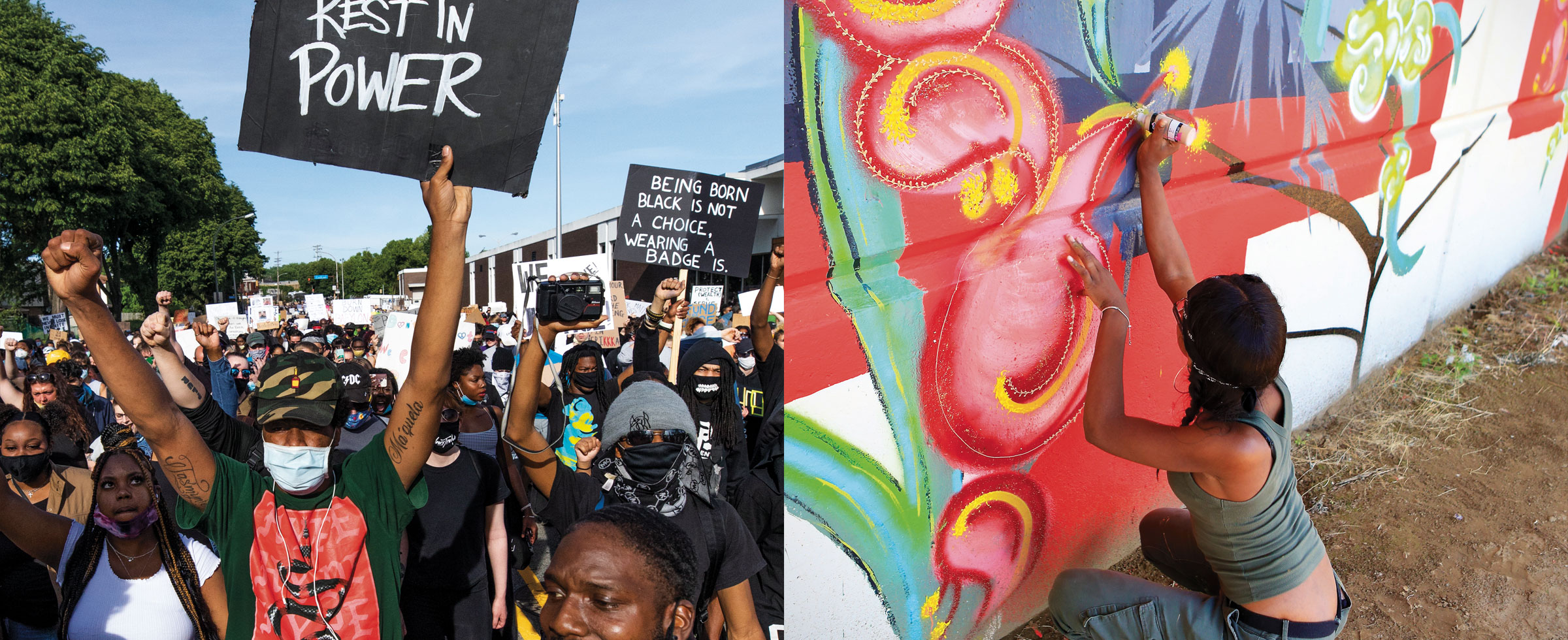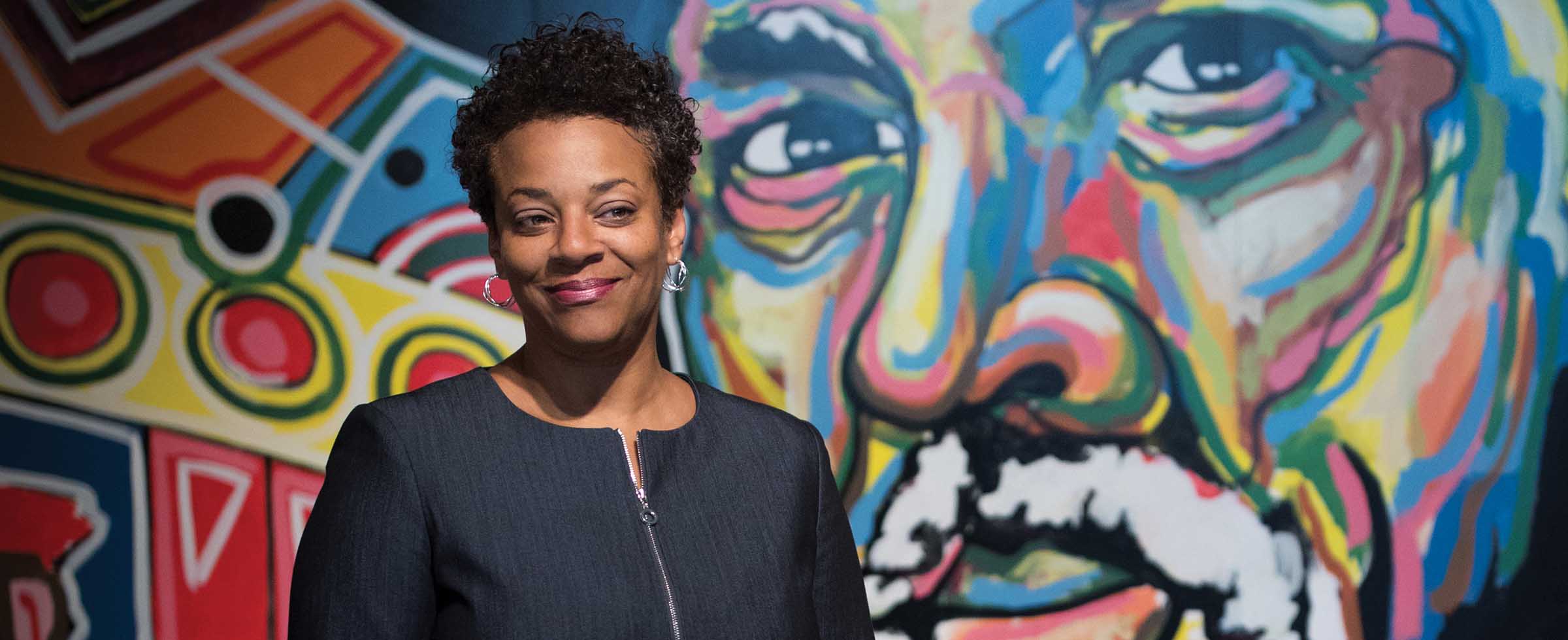Bearing WitnessA former Pittsburgh journalist assigned to the Race Beat reflects on decades of struggle for racial equity in the city

Hundreds gather in Pittsburgh’s East Liberty neighborhood on June 1 to protest police violence. Black men are more than twice as likely as whites to be killed by police. Image by Joshua Franzos.
On Memorial Day in Minneapolis, a city nearly 1,000 miles west of Pittsburgh, three police officers pinned to the asphalt an unarmed Black man accused of passing a counterfeit $20 bill. A white officer, his left hand slipped nonchalantly in his pocket, pressed his knee into George Floyd’s neck for 8 minutes 46 seconds, unrelenting even as Mr. Floyd pleaded repeatedly, “I can’t breathe.”
The killing, captured on video for all to see, galvanized a world shut down by the pandemic. For weeks, outrage over Mr. Floyd’s death propelled protesters into the streets around the world, including in Pittsburgh, a city that has seen its share of institutional violence against Black and Brown bodies. That history includes a hauntingly similar killing 25 years ago when white suburban police officers choked to death an unarmed Black businessman, Jonny Gammage, on a dark and empty city street after a traffic stop.
In the quarter-century since, the Black community in Pittsburgh has continuously borne witness to — that is, called out and railed against — institutional racism as police here killed and maimed Black men again and again and as study after study showed the Black community disproportionately pummeled by disease, low wages, evictions, unemployment, violence and inequities in education.
The city’s power brokers didn’t listen, however. Little changed.
I know this well because I have been covering these issues since 1996. That is when my former employer, the Pittsburgh Post-Gazette, assigned me to the race beat, a special area of coverage devoted to reporting on the Black community. It’s through those experiences and relationships that I reflect now on the racial struggle in Pittsburgh and what brings the city and its concerned citizens into this moment.
On the race beat, I wanted to explore the souls of Black folks. I wanted to hear the voices and the stories of the people who were most marginalized by the social construct. How did they survive? How did they find joy amid the oppression of the larger, dominant society?
To get closer to answering these questions. I moved from the largely Jewish community of Squirrel Hill and planted myself in Crawford Square, a redeveloping neighborhood in the Hill District, arguably the center of the Black community in Pittsburgh.
But I also took my reporter’s notebook into Homewood, Hazelwood, Beltzhoover and other communities where Black people worshipped, married, had cookouts and cut their grass.
I had conversations about Black lives and the intersection of education, politics, poverty, affirmative action, police brutality and other social issues. I spoke with small business owners, librarians, school principals, janitors, professors, student dropouts, street preachers. My notebooks runneth over.
I quickly realized that I was bearing witness to a community of people bearing witness. Years before there was the language of being anti-racist, there was this steadfast community that witnessed — that testified to and took action against — inequality. They saw that Black and Brown folks were not the problem. The power and privilege that came with whiteness was the problem.
The people that I reported on were leading efforts that called for “humanizing” Black people. They argued this could catalyze change. To recognize the souls of Black folks would make it harder to underfund their schools, to release cancerous particulates into the air their babies breathed, to build casinos in their backyards instead of grocery stores, and to choke the life out of unarmed Black men on dark roads during traffic stops. Although the Black Lives Matter movement didn’t exist then, those I covered were pushing to demonstrate to others that Black lives always mattered.
They mattered to the friends and family of Jonny Gammage. They mattered to the relatives of Jerry Jackson, who was killed in April 1995, six months before Gammage, in a barrage of 51 bullets fired by officers in the Armstrong Tunnels at the end of a five-mile, high-speed chase. They mattered in January 2010, when then–18-year-old Jordan Miles was walking from his mother’s house to his grandmother’s and plainclothes officers jumped from an unmarked car, then chased and tackled him in a confrontation that left him missing chunks of hair and his face so bruised and swollen that his mother didn’t recognize him the following evening. They mattered in November 2012 when police misidentified 19-year-old Leon Ford during a traffic stop and shot him multiple times, leaving him paralyzed. And they mattered in June 2018, when an East Pittsburgh policeman fatally shot 17-year-old Antwon Rose II in the back as he was fleeing from the officer.
Beyond bigoted policing and state-sanctioned violence, people of color in Pittsburgh contended with health care, economic and educational disparities. In the 1990s, Black residents were six times more likely to be infected with HIV than white residents, as the infection increasingly struck women who were impoverished and Black. While the numbers of new infections are down, the rate at which Black men were infected in 2017, the most recent year for which statistics are available, was five times that of white men, and for Black women, the rate was more than 16 times that for white women.
Also, at the beginning of the 1990s, Black infants in Allegheny County were four times more likely to die in their first year of life than white infants. The Black infant mortality rate of 24 per 1,000 was worse than that in many Third World nations. Today, Black infants in Allegheny County die at a rate that is 4.5 times that of white babies.
In 2007, the University of Pittsburgh released its first report showing how inhumane life was for African Americans in Allegheny County. In health, education, economics, housing and just about every other factor evaluated, Blacks were at the bottom of the well. More than 10 years later, little, if anything, had changed. Pittsburgh remained a tale of two cities: Most livable for whites, not so much for Blacks.
A report by Pitt researchers and the City’s Gender Equity Commission in 2019 found quality of life outcomes so horrible here for Black residents, particularly Black women, that simply by moving away people of color could instantly improve their lives.
That is exactly what thousands did. Between 2014 and 2018, nearly 7,000 Black residents left Pittsburgh. It was one of the largest out-migrations of African Americans from Pittsburgh ever.
And now, layered on top of everything else, there’s the economic and health devastation of COVID-19. Businesses furloughed people of color at a higher rate, and many of those people teetered on the edge of eviction and hunger because the wages and savings of Black and Brown people, particularly Black and Brown women, already paled before those of the majority.
In addition, Black businesses, which historically have access to less capital, were more likely to be located in virus hot spots or affiliated with the service industry and, as a result, shut down in disproportionately high numbers.
Inferior and dense housing has made quarantining improbable for many Black families. Economic and educational inequalities mean that many people of color are front-line workers, putting their lives at risk to deliver packages, stock grocery shelves, clean buildings and keep buses running. This may explain why Blacks in Allegheny County are getting infected with COVID at twice the rate of whites. In addition, decades of living with chronic stress, discrimination and low-income jobs that fail to provide health insurance mean people of color are more likely to have the pre-existing health conditions that raise the death rate from COVID.
Considering the effects of COVID, as well as the city’s record of discrimination and diminished life prospects for people of color, leaving Pittsburgh behind might be the easier choice, but the vast majority of Black Pittsburghers have chosen to stay. There has always been a moral coalition of Black Pittsburghers and “woke” others bearing witness to the intersection of race and structural discrimination attached to housing, employment and health. They stayed; they fought on, confronting ugliness, pushing for change. Their very act of staying was an act of resistance.
Those who remained include activists like writer Damon Young, who likened the city’s maintenance of a white power and cultural structure to being a “spiritual whiteness … a jar of mayonnaise” that suffocates the Black experience. Community activist Brandi Fisher, executive director of the Alliance for Police Accountability, stayed. She explained in an op-ed in June, “When we say defund the police, we are arguing that it’s time to dispense with the idea that police officers keep communities safe, at least when it comes to Black and Brown people.”
La’Tasha Mayes and Jasiri X didn’t abandon the city either. She is a nationally recognized leader for reproductive justice, on a mission to stop the “dangerous laws set out to control” Black women’s bodies.
He is an artist who gained international acclaim for using music and media to educate youth and call out institutional racism. He also challenges the media to always “consider the humanity of Black and Brown people.”
There’s a new generation of protesters, too, risking exposure to COVID to demonstrate day after day in Pittsburgh streets. They’ve been joined by white residents from such white-dominant suburbs as Mt. Lebanon and Murrysville who are reckoning with how their own behaviors and prejudices support and maintain racist structures. These are white people who saw the humanity in George Floyd. They were horrified when they watched it choked out of him.
And this time, there’s evidence that the city’s power brokers are starting to listen. Protesters symbolically nailed to the courthouse door on Grant Street a list of demands for police reform. Already, Pittsburgh officials have implemented some of them, including banning chokeholds and moving money from the police budget to a fund devoted to reducing violence. Allegheny County Council is working on a police reform bill as well. And executives, civic leaders and corporations across the region have, at the very least, issued statements sympathetic to the protesters’ demands for change and committed themselves to participate in that change.
The fix is not that easy, though. Huge structural change must occur across the board to effect real improvement in the lives of Pittsburgh’s people of color.
The young people who dominated protests on Pittsburgh’s streets aren’t letting up in their demands for real change. They have demonstrated in memory of George Floyd, but they also have demanded that Pittsburgh confront its own history. On July 20, which would have been Jonny Gammage’s 56th birthday, more than 50 young people, some not yet born when Mr. Gammage was killed, marched down Route 51 where he died.
That’s the work of securing freedom and justice to which it continues to be important to bear witness.
Original story appeared in the 2019-20 Annual Report.




